Critical Examination of Alcohol Consumption and Addiction Theories
VerifiedAdded on 2022/08/12
|15
|4254
|30
Essay
AI Summary
This essay provides an in-depth analysis of alcohol consumption and substance misuse, focusing on its prevalence, the underlying reasons for addiction, and the various contexts and consequences associated with it. The essay examines the physical, psychological, pharmacological, legal, and social factors influencing substance use, drawing on statistics from the United Kingdom to illustrate the scope of the issue. It explores prominent theories of addiction, including the socio-cognitive theory and the normalization theory, and discusses the impact of substance misuse on individuals, families, and society. The role of media, government policies, and public health campaigns is also evaluated. The analysis includes an examination of the Misuse of Drugs Act 1971 and its implications, offering a comprehensive overview of the multifaceted challenges posed by alcohol consumption and substance misuse.
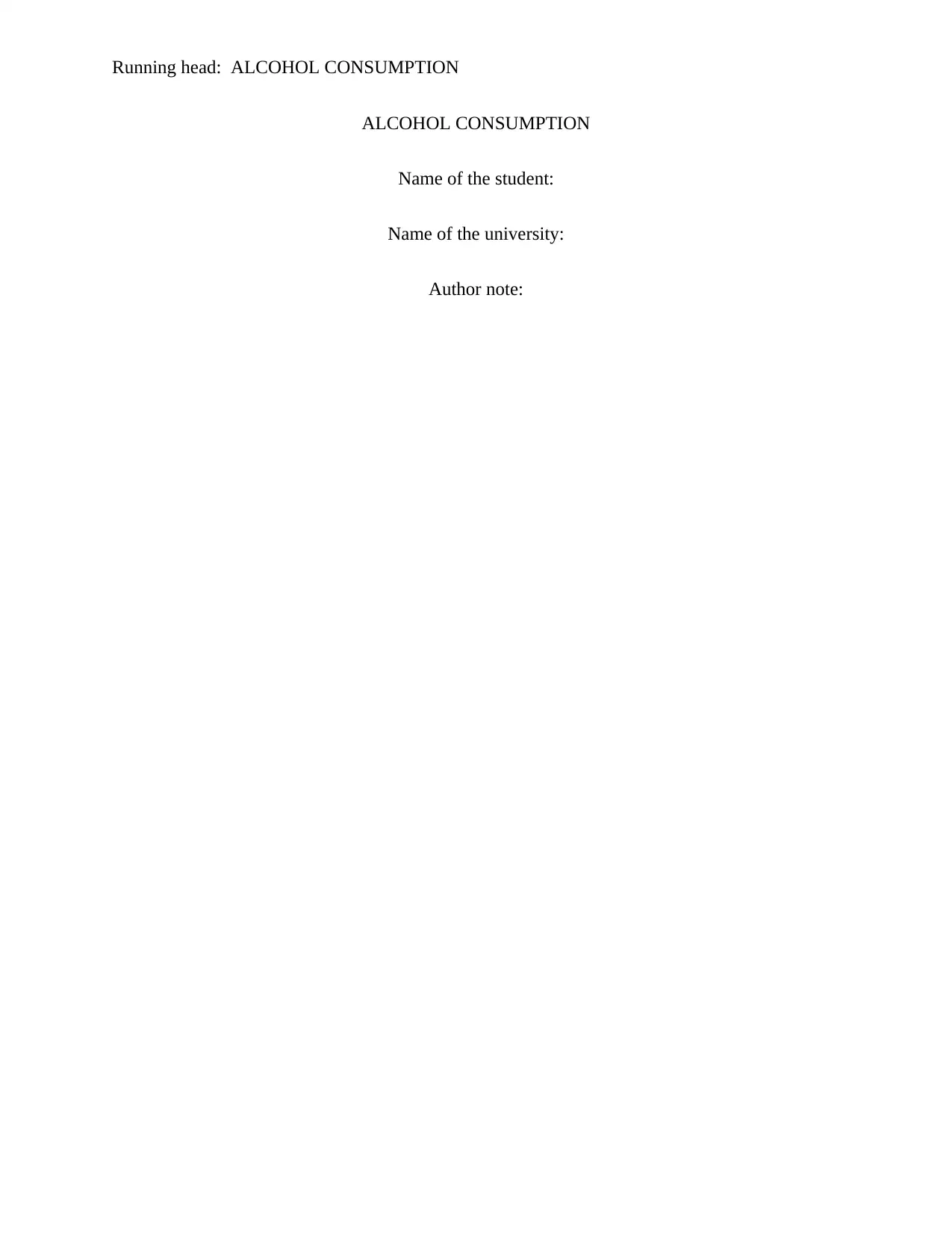
Running head: ALCOHOL CONSUMPTION
ALCOHOL CONSUMPTION
Name of the student:
Name of the university:
Author note:
ALCOHOL CONSUMPTION
Name of the student:
Name of the university:
Author note:
Paraphrase This Document
Need a fresh take? Get an instant paraphrase of this document with our AI Paraphraser
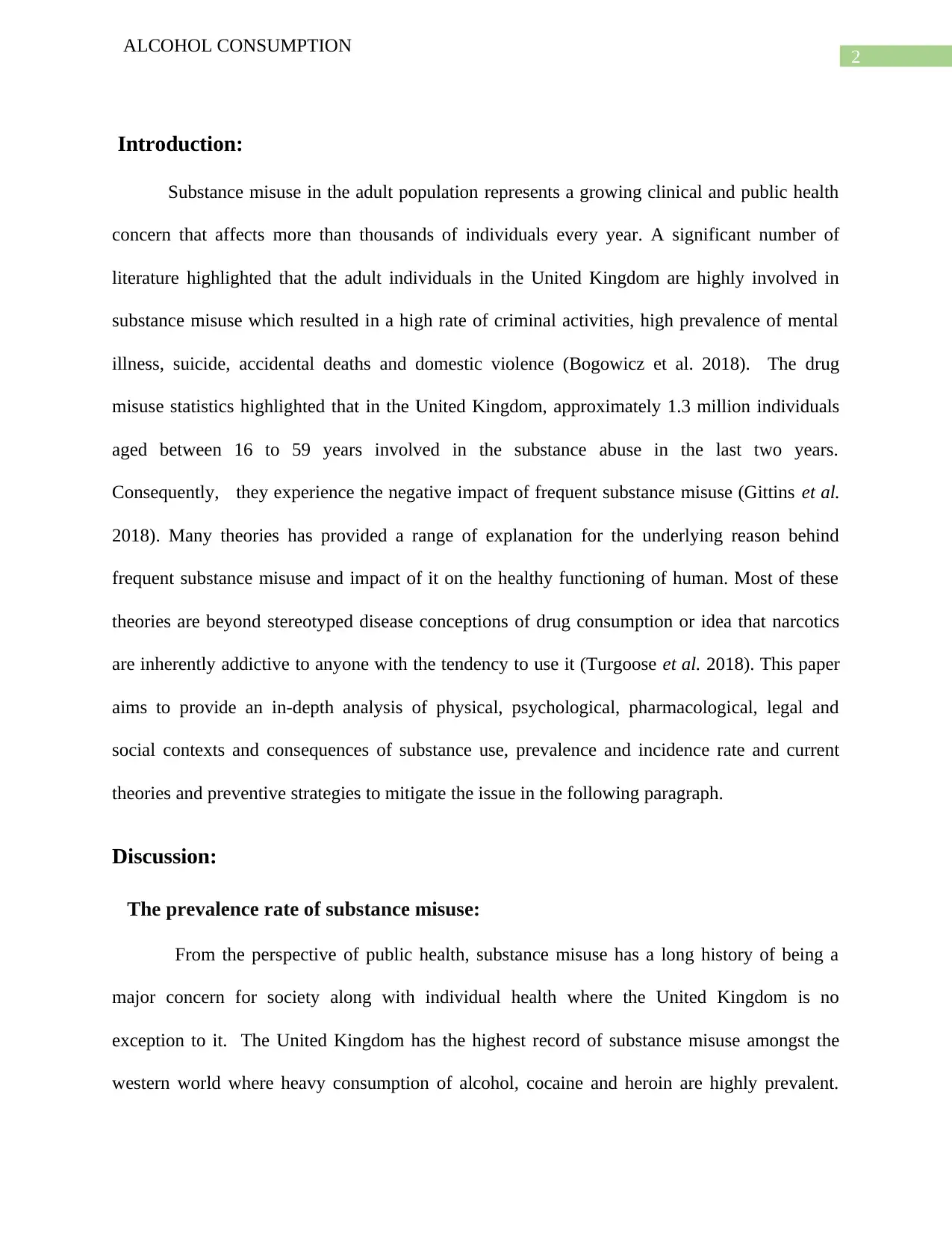
2
ALCOHOL CONSUMPTION
Introduction:
Substance misuse in the adult population represents a growing clinical and public health
concern that affects more than thousands of individuals every year. A significant number of
literature highlighted that the adult individuals in the United Kingdom are highly involved in
substance misuse which resulted in a high rate of criminal activities, high prevalence of mental
illness, suicide, accidental deaths and domestic violence (Bogowicz et al. 2018). The drug
misuse statistics highlighted that in the United Kingdom, approximately 1.3 million individuals
aged between 16 to 59 years involved in the substance abuse in the last two years.
Consequently, they experience the negative impact of frequent substance misuse (Gittins et al.
2018). Many theories has provided a range of explanation for the underlying reason behind
frequent substance misuse and impact of it on the healthy functioning of human. Most of these
theories are beyond stereotyped disease conceptions of drug consumption or idea that narcotics
are inherently addictive to anyone with the tendency to use it (Turgoose et al. 2018). This paper
aims to provide an in-depth analysis of physical, psychological, pharmacological, legal and
social contexts and consequences of substance use, prevalence and incidence rate and current
theories and preventive strategies to mitigate the issue in the following paragraph.
Discussion:
The prevalence rate of substance misuse:
From the perspective of public health, substance misuse has a long history of being a
major concern for society along with individual health where the United Kingdom is no
exception to it. The United Kingdom has the highest record of substance misuse amongst the
western world where heavy consumption of alcohol, cocaine and heroin are highly prevalent.
ALCOHOL CONSUMPTION
Introduction:
Substance misuse in the adult population represents a growing clinical and public health
concern that affects more than thousands of individuals every year. A significant number of
literature highlighted that the adult individuals in the United Kingdom are highly involved in
substance misuse which resulted in a high rate of criminal activities, high prevalence of mental
illness, suicide, accidental deaths and domestic violence (Bogowicz et al. 2018). The drug
misuse statistics highlighted that in the United Kingdom, approximately 1.3 million individuals
aged between 16 to 59 years involved in the substance abuse in the last two years.
Consequently, they experience the negative impact of frequent substance misuse (Gittins et al.
2018). Many theories has provided a range of explanation for the underlying reason behind
frequent substance misuse and impact of it on the healthy functioning of human. Most of these
theories are beyond stereotyped disease conceptions of drug consumption or idea that narcotics
are inherently addictive to anyone with the tendency to use it (Turgoose et al. 2018). This paper
aims to provide an in-depth analysis of physical, psychological, pharmacological, legal and
social contexts and consequences of substance use, prevalence and incidence rate and current
theories and preventive strategies to mitigate the issue in the following paragraph.
Discussion:
The prevalence rate of substance misuse:
From the perspective of public health, substance misuse has a long history of being a
major concern for society along with individual health where the United Kingdom is no
exception to it. The United Kingdom has the highest record of substance misuse amongst the
western world where heavy consumption of alcohol, cocaine and heroin are highly prevalent.
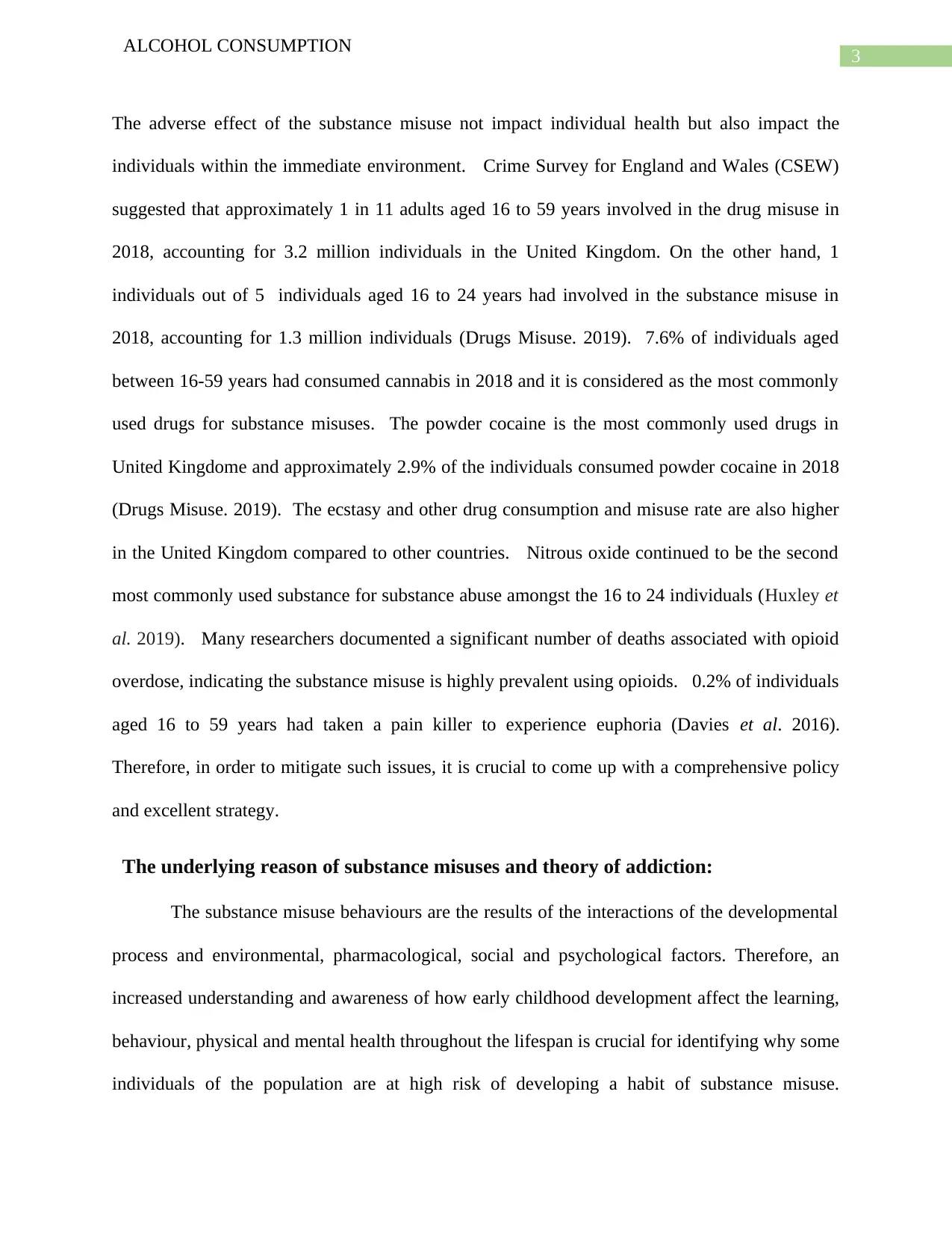
3
ALCOHOL CONSUMPTION
The adverse effect of the substance misuse not impact individual health but also impact the
individuals within the immediate environment. Crime Survey for England and Wales (CSEW)
suggested that approximately 1 in 11 adults aged 16 to 59 years involved in the drug misuse in
2018, accounting for 3.2 million individuals in the United Kingdom. On the other hand, 1
individuals out of 5 individuals aged 16 to 24 years had involved in the substance misuse in
2018, accounting for 1.3 million individuals (Drugs Misuse. 2019). 7.6% of individuals aged
between 16-59 years had consumed cannabis in 2018 and it is considered as the most commonly
used drugs for substance misuses. The powder cocaine is the most commonly used drugs in
United Kingdome and approximately 2.9% of the individuals consumed powder cocaine in 2018
(Drugs Misuse. 2019). The ecstasy and other drug consumption and misuse rate are also higher
in the United Kingdom compared to other countries. Nitrous oxide continued to be the second
most commonly used substance for substance abuse amongst the 16 to 24 individuals (Huxley et
al. 2019). Many researchers documented a significant number of deaths associated with opioid
overdose, indicating the substance misuse is highly prevalent using opioids. 0.2% of individuals
aged 16 to 59 years had taken a pain killer to experience euphoria (Davies et al. 2016).
Therefore, in order to mitigate such issues, it is crucial to come up with a comprehensive policy
and excellent strategy.
The underlying reason of substance misuses and theory of addiction:
The substance misuse behaviours are the results of the interactions of the developmental
process and environmental, pharmacological, social and psychological factors. Therefore, an
increased understanding and awareness of how early childhood development affect the learning,
behaviour, physical and mental health throughout the lifespan is crucial for identifying why some
individuals of the population are at high risk of developing a habit of substance misuse.
ALCOHOL CONSUMPTION
The adverse effect of the substance misuse not impact individual health but also impact the
individuals within the immediate environment. Crime Survey for England and Wales (CSEW)
suggested that approximately 1 in 11 adults aged 16 to 59 years involved in the drug misuse in
2018, accounting for 3.2 million individuals in the United Kingdom. On the other hand, 1
individuals out of 5 individuals aged 16 to 24 years had involved in the substance misuse in
2018, accounting for 1.3 million individuals (Drugs Misuse. 2019). 7.6% of individuals aged
between 16-59 years had consumed cannabis in 2018 and it is considered as the most commonly
used drugs for substance misuses. The powder cocaine is the most commonly used drugs in
United Kingdome and approximately 2.9% of the individuals consumed powder cocaine in 2018
(Drugs Misuse. 2019). The ecstasy and other drug consumption and misuse rate are also higher
in the United Kingdom compared to other countries. Nitrous oxide continued to be the second
most commonly used substance for substance abuse amongst the 16 to 24 individuals (Huxley et
al. 2019). Many researchers documented a significant number of deaths associated with opioid
overdose, indicating the substance misuse is highly prevalent using opioids. 0.2% of individuals
aged 16 to 59 years had taken a pain killer to experience euphoria (Davies et al. 2016).
Therefore, in order to mitigate such issues, it is crucial to come up with a comprehensive policy
and excellent strategy.
The underlying reason of substance misuses and theory of addiction:
The substance misuse behaviours are the results of the interactions of the developmental
process and environmental, pharmacological, social and psychological factors. Therefore, an
increased understanding and awareness of how early childhood development affect the learning,
behaviour, physical and mental health throughout the lifespan is crucial for identifying why some
individuals of the population are at high risk of developing a habit of substance misuse.
⊘ This is a preview!⊘
Do you want full access?
Subscribe today to unlock all pages.

Trusted by 1+ million students worldwide
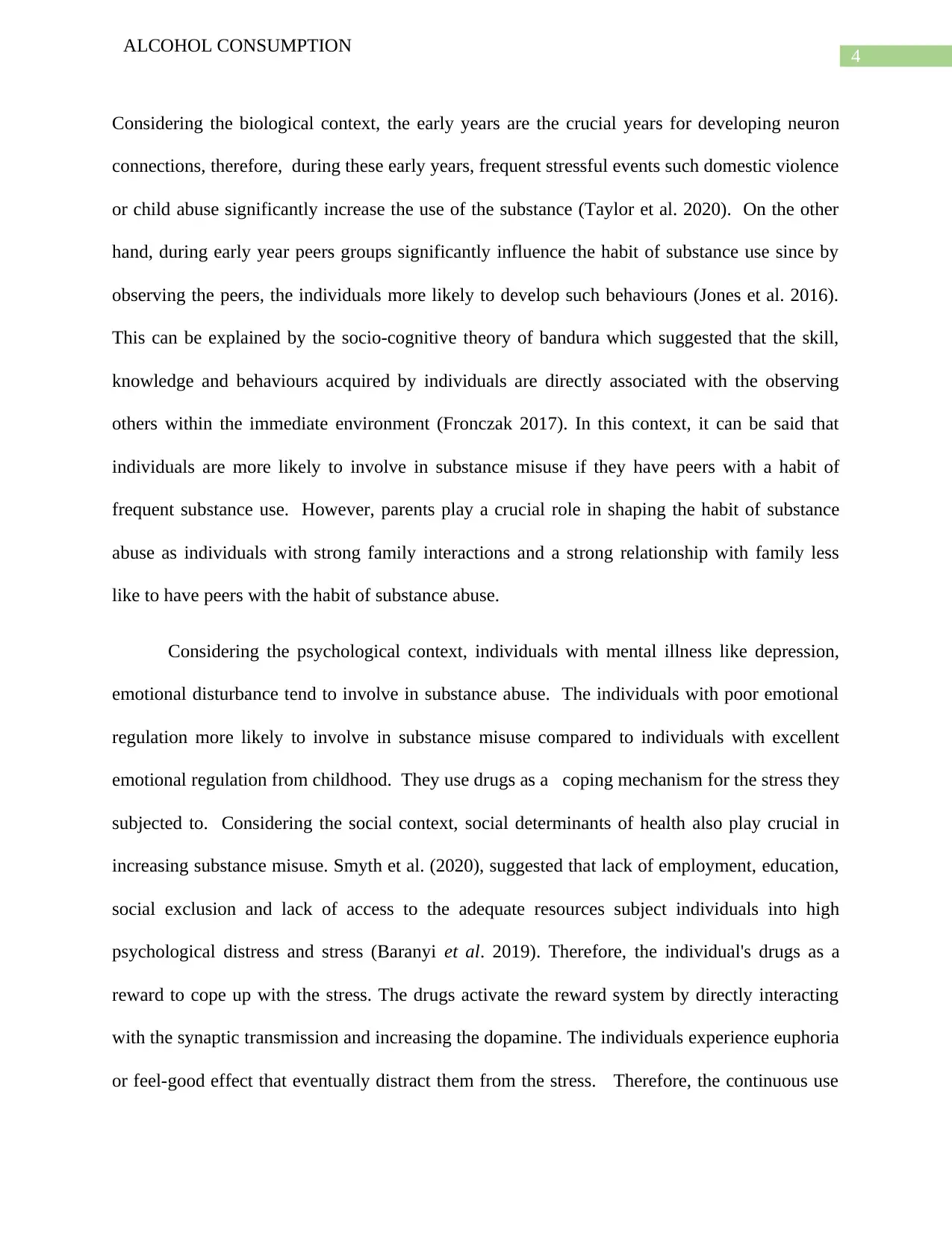
4
ALCOHOL CONSUMPTION
Considering the biological context, the early years are the crucial years for developing neuron
connections, therefore, during these early years, frequent stressful events such domestic violence
or child abuse significantly increase the use of the substance (Taylor et al. 2020). On the other
hand, during early year peers groups significantly influence the habit of substance use since by
observing the peers, the individuals more likely to develop such behaviours (Jones et al. 2016).
This can be explained by the socio-cognitive theory of bandura which suggested that the skill,
knowledge and behaviours acquired by individuals are directly associated with the observing
others within the immediate environment (Fronczak 2017). In this context, it can be said that
individuals are more likely to involve in substance misuse if they have peers with a habit of
frequent substance use. However, parents play a crucial role in shaping the habit of substance
abuse as individuals with strong family interactions and a strong relationship with family less
like to have peers with the habit of substance abuse.
Considering the psychological context, individuals with mental illness like depression,
emotional disturbance tend to involve in substance abuse. The individuals with poor emotional
regulation more likely to involve in substance misuse compared to individuals with excellent
emotional regulation from childhood. They use drugs as a coping mechanism for the stress they
subjected to. Considering the social context, social determinants of health also play crucial in
increasing substance misuse. Smyth et al. (2020), suggested that lack of employment, education,
social exclusion and lack of access to the adequate resources subject individuals into high
psychological distress and stress (Baranyi et al. 2019). Therefore, the individual's drugs as a
reward to cope up with the stress. The drugs activate the reward system by directly interacting
with the synaptic transmission and increasing the dopamine. The individuals experience euphoria
or feel-good effect that eventually distract them from the stress. Therefore, the continuous use
ALCOHOL CONSUMPTION
Considering the biological context, the early years are the crucial years for developing neuron
connections, therefore, during these early years, frequent stressful events such domestic violence
or child abuse significantly increase the use of the substance (Taylor et al. 2020). On the other
hand, during early year peers groups significantly influence the habit of substance use since by
observing the peers, the individuals more likely to develop such behaviours (Jones et al. 2016).
This can be explained by the socio-cognitive theory of bandura which suggested that the skill,
knowledge and behaviours acquired by individuals are directly associated with the observing
others within the immediate environment (Fronczak 2017). In this context, it can be said that
individuals are more likely to involve in substance misuse if they have peers with a habit of
frequent substance use. However, parents play a crucial role in shaping the habit of substance
abuse as individuals with strong family interactions and a strong relationship with family less
like to have peers with the habit of substance abuse.
Considering the psychological context, individuals with mental illness like depression,
emotional disturbance tend to involve in substance abuse. The individuals with poor emotional
regulation more likely to involve in substance misuse compared to individuals with excellent
emotional regulation from childhood. They use drugs as a coping mechanism for the stress they
subjected to. Considering the social context, social determinants of health also play crucial in
increasing substance misuse. Smyth et al. (2020), suggested that lack of employment, education,
social exclusion and lack of access to the adequate resources subject individuals into high
psychological distress and stress (Baranyi et al. 2019). Therefore, the individual's drugs as a
reward to cope up with the stress. The drugs activate the reward system by directly interacting
with the synaptic transmission and increasing the dopamine. The individuals experience euphoria
or feel-good effect that eventually distract them from the stress. Therefore, the continuous use
Paraphrase This Document
Need a fresh take? Get an instant paraphrase of this document with our AI Paraphraser
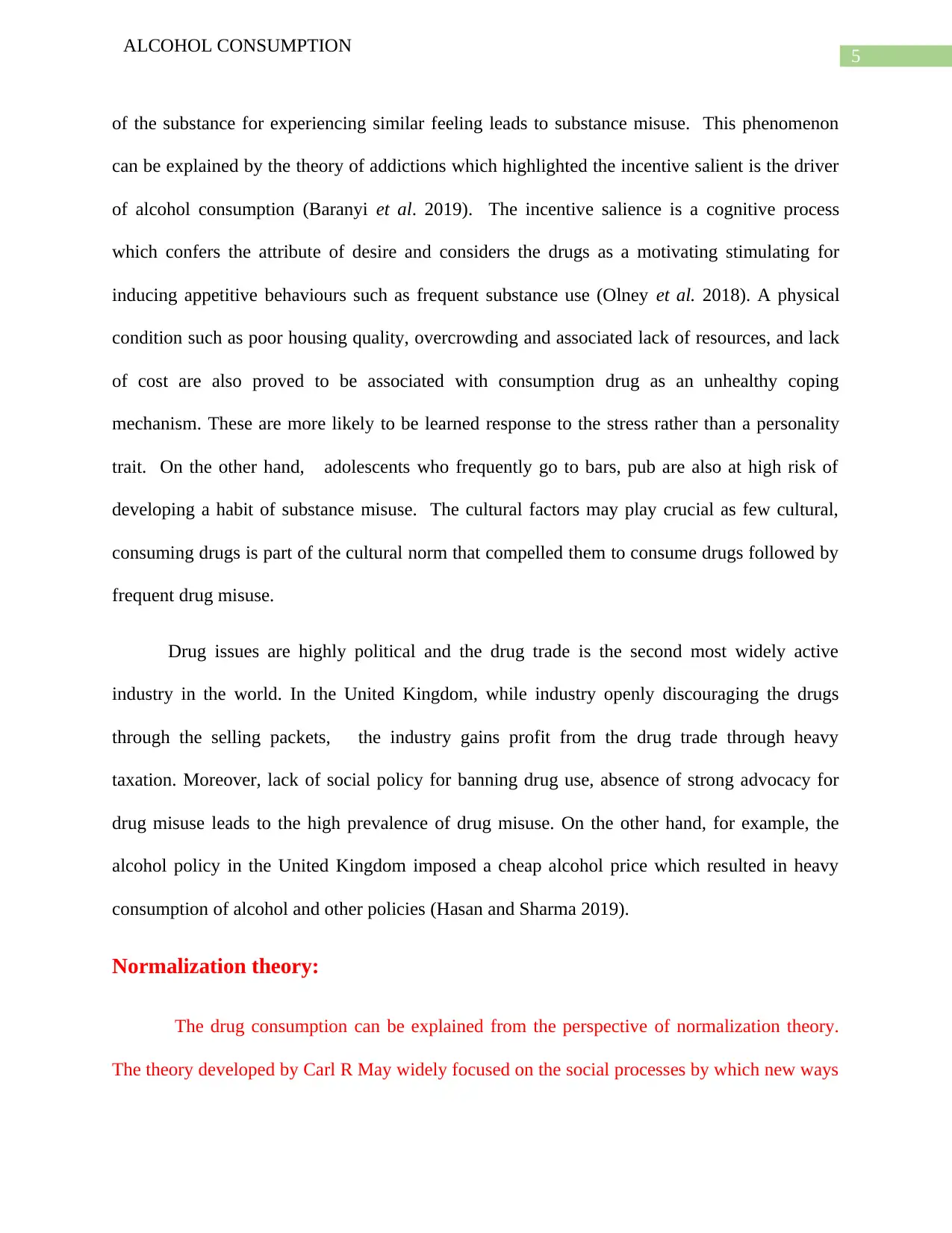
5
ALCOHOL CONSUMPTION
of the substance for experiencing similar feeling leads to substance misuse. This phenomenon
can be explained by the theory of addictions which highlighted the incentive salient is the driver
of alcohol consumption (Baranyi et al. 2019). The incentive salience is a cognitive process
which confers the attribute of desire and considers the drugs as a motivating stimulating for
inducing appetitive behaviours such as frequent substance use (Olney et al. 2018). A physical
condition such as poor housing quality, overcrowding and associated lack of resources, and lack
of cost are also proved to be associated with consumption drug as an unhealthy coping
mechanism. These are more likely to be learned response to the stress rather than a personality
trait. On the other hand, adolescents who frequently go to bars, pub are also at high risk of
developing a habit of substance misuse. The cultural factors may play crucial as few cultural,
consuming drugs is part of the cultural norm that compelled them to consume drugs followed by
frequent drug misuse.
Drug issues are highly political and the drug trade is the second most widely active
industry in the world. In the United Kingdom, while industry openly discouraging the drugs
through the selling packets, the industry gains profit from the drug trade through heavy
taxation. Moreover, lack of social policy for banning drug use, absence of strong advocacy for
drug misuse leads to the high prevalence of drug misuse. On the other hand, for example, the
alcohol policy in the United Kingdom imposed a cheap alcohol price which resulted in heavy
consumption of alcohol and other policies (Hasan and Sharma 2019).
Normalization theory:
The drug consumption can be explained from the perspective of normalization theory.
The theory developed by Carl R May widely focused on the social processes by which new ways
ALCOHOL CONSUMPTION
of the substance for experiencing similar feeling leads to substance misuse. This phenomenon
can be explained by the theory of addictions which highlighted the incentive salient is the driver
of alcohol consumption (Baranyi et al. 2019). The incentive salience is a cognitive process
which confers the attribute of desire and considers the drugs as a motivating stimulating for
inducing appetitive behaviours such as frequent substance use (Olney et al. 2018). A physical
condition such as poor housing quality, overcrowding and associated lack of resources, and lack
of cost are also proved to be associated with consumption drug as an unhealthy coping
mechanism. These are more likely to be learned response to the stress rather than a personality
trait. On the other hand, adolescents who frequently go to bars, pub are also at high risk of
developing a habit of substance misuse. The cultural factors may play crucial as few cultural,
consuming drugs is part of the cultural norm that compelled them to consume drugs followed by
frequent drug misuse.
Drug issues are highly political and the drug trade is the second most widely active
industry in the world. In the United Kingdom, while industry openly discouraging the drugs
through the selling packets, the industry gains profit from the drug trade through heavy
taxation. Moreover, lack of social policy for banning drug use, absence of strong advocacy for
drug misuse leads to the high prevalence of drug misuse. On the other hand, for example, the
alcohol policy in the United Kingdom imposed a cheap alcohol price which resulted in heavy
consumption of alcohol and other policies (Hasan and Sharma 2019).
Normalization theory:
The drug consumption can be explained from the perspective of normalization theory.
The theory developed by Carl R May widely focused on the social processes by which new ways
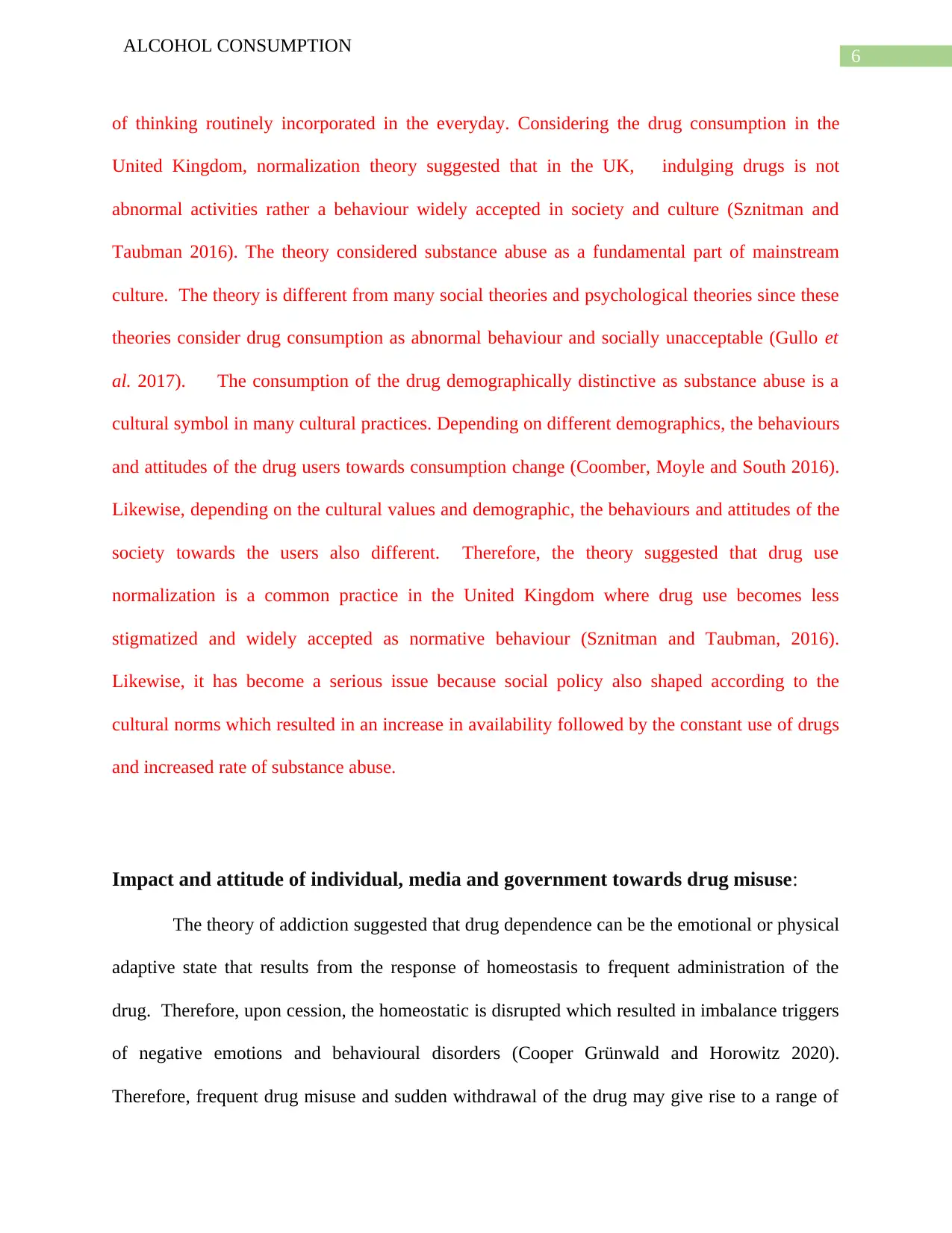
6
ALCOHOL CONSUMPTION
of thinking routinely incorporated in the everyday. Considering the drug consumption in the
United Kingdom, normalization theory suggested that in the UK, indulging drugs is not
abnormal activities rather a behaviour widely accepted in society and culture (Sznitman and
Taubman 2016). The theory considered substance abuse as a fundamental part of mainstream
culture. The theory is different from many social theories and psychological theories since these
theories consider drug consumption as abnormal behaviour and socially unacceptable (Gullo et
al. 2017). The consumption of the drug demographically distinctive as substance abuse is a
cultural symbol in many cultural practices. Depending on different demographics, the behaviours
and attitudes of the drug users towards consumption change (Coomber, Moyle and South 2016).
Likewise, depending on the cultural values and demographic, the behaviours and attitudes of the
society towards the users also different. Therefore, the theory suggested that drug use
normalization is a common practice in the United Kingdom where drug use becomes less
stigmatized and widely accepted as normative behaviour (Sznitman and Taubman, 2016).
Likewise, it has become a serious issue because social policy also shaped according to the
cultural norms which resulted in an increase in availability followed by the constant use of drugs
and increased rate of substance abuse.
Impact and attitude of individual, media and government towards drug misuse:
The theory of addiction suggested that drug dependence can be the emotional or physical
adaptive state that results from the response of homeostasis to frequent administration of the
drug. Therefore, upon cession, the homeostatic is disrupted which resulted in imbalance triggers
of negative emotions and behavioural disorders (Cooper Grünwald and Horowitz 2020).
Therefore, frequent drug misuse and sudden withdrawal of the drug may give rise to a range of
ALCOHOL CONSUMPTION
of thinking routinely incorporated in the everyday. Considering the drug consumption in the
United Kingdom, normalization theory suggested that in the UK, indulging drugs is not
abnormal activities rather a behaviour widely accepted in society and culture (Sznitman and
Taubman 2016). The theory considered substance abuse as a fundamental part of mainstream
culture. The theory is different from many social theories and psychological theories since these
theories consider drug consumption as abnormal behaviour and socially unacceptable (Gullo et
al. 2017). The consumption of the drug demographically distinctive as substance abuse is a
cultural symbol in many cultural practices. Depending on different demographics, the behaviours
and attitudes of the drug users towards consumption change (Coomber, Moyle and South 2016).
Likewise, depending on the cultural values and demographic, the behaviours and attitudes of the
society towards the users also different. Therefore, the theory suggested that drug use
normalization is a common practice in the United Kingdom where drug use becomes less
stigmatized and widely accepted as normative behaviour (Sznitman and Taubman, 2016).
Likewise, it has become a serious issue because social policy also shaped according to the
cultural norms which resulted in an increase in availability followed by the constant use of drugs
and increased rate of substance abuse.
Impact and attitude of individual, media and government towards drug misuse:
The theory of addiction suggested that drug dependence can be the emotional or physical
adaptive state that results from the response of homeostasis to frequent administration of the
drug. Therefore, upon cession, the homeostatic is disrupted which resulted in imbalance triggers
of negative emotions and behavioural disorders (Cooper Grünwald and Horowitz 2020).
Therefore, frequent drug misuse and sudden withdrawal of the drug may give rise to a range of
⊘ This is a preview!⊘
Do you want full access?
Subscribe today to unlock all pages.

Trusted by 1+ million students worldwide
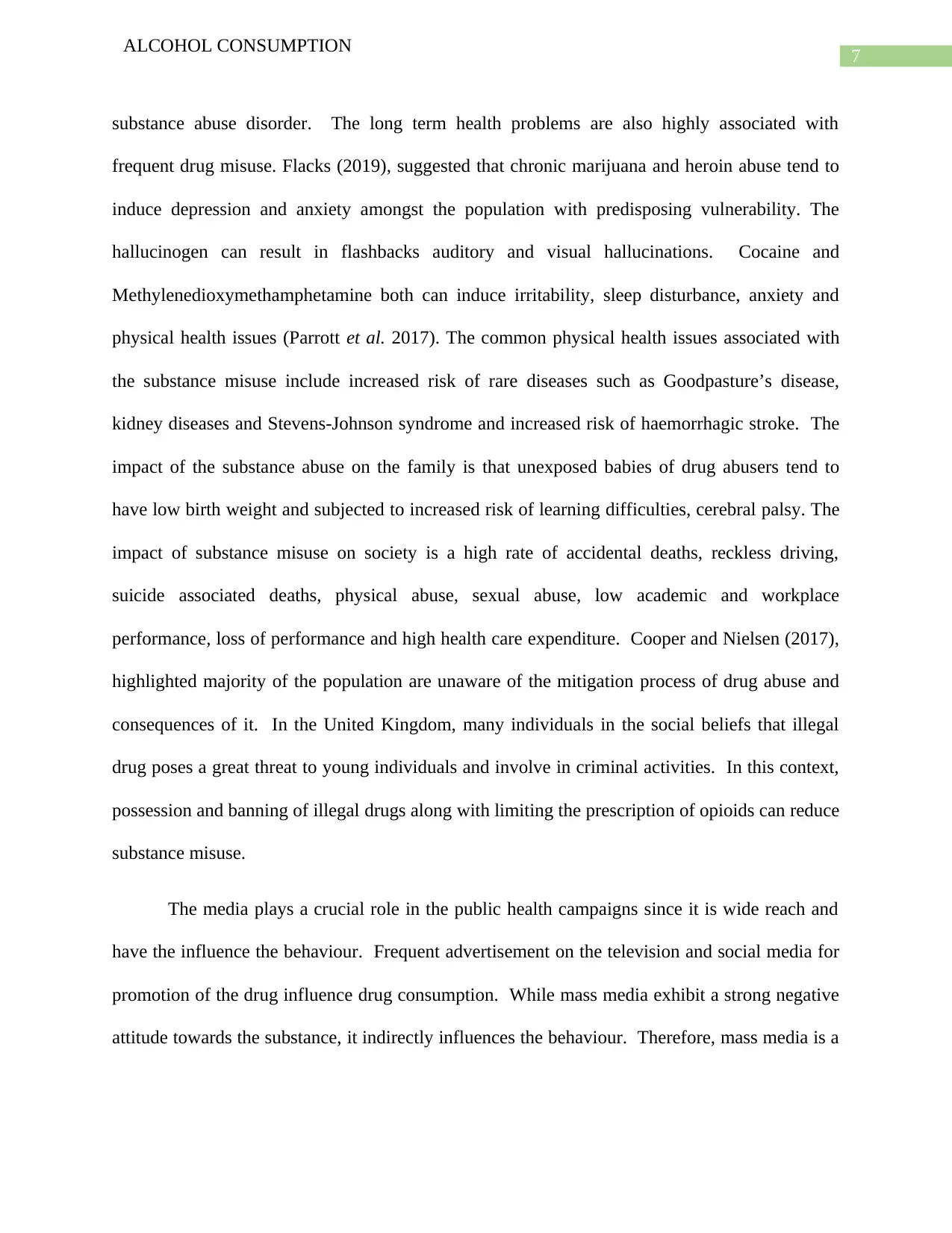
7
ALCOHOL CONSUMPTION
substance abuse disorder. The long term health problems are also highly associated with
frequent drug misuse. Flacks (2019), suggested that chronic marijuana and heroin abuse tend to
induce depression and anxiety amongst the population with predisposing vulnerability. The
hallucinogen can result in flashbacks auditory and visual hallucinations. Cocaine and
Methylenedioxymethamphetamine both can induce irritability, sleep disturbance, anxiety and
physical health issues (Parrott et al. 2017). The common physical health issues associated with
the substance misuse include increased risk of rare diseases such as Goodpasture’s disease,
kidney diseases and Stevens-Johnson syndrome and increased risk of haemorrhagic stroke. The
impact of the substance abuse on the family is that unexposed babies of drug abusers tend to
have low birth weight and subjected to increased risk of learning difficulties, cerebral palsy. The
impact of substance misuse on society is a high rate of accidental deaths, reckless driving,
suicide associated deaths, physical abuse, sexual abuse, low academic and workplace
performance, loss of performance and high health care expenditure. Cooper and Nielsen (2017),
highlighted majority of the population are unaware of the mitigation process of drug abuse and
consequences of it. In the United Kingdom, many individuals in the social beliefs that illegal
drug poses a great threat to young individuals and involve in criminal activities. In this context,
possession and banning of illegal drugs along with limiting the prescription of opioids can reduce
substance misuse.
The media plays a crucial role in the public health campaigns since it is wide reach and
have the influence the behaviour. Frequent advertisement on the television and social media for
promotion of the drug influence drug consumption. While mass media exhibit a strong negative
attitude towards the substance, it indirectly influences the behaviour. Therefore, mass media is a
ALCOHOL CONSUMPTION
substance abuse disorder. The long term health problems are also highly associated with
frequent drug misuse. Flacks (2019), suggested that chronic marijuana and heroin abuse tend to
induce depression and anxiety amongst the population with predisposing vulnerability. The
hallucinogen can result in flashbacks auditory and visual hallucinations. Cocaine and
Methylenedioxymethamphetamine both can induce irritability, sleep disturbance, anxiety and
physical health issues (Parrott et al. 2017). The common physical health issues associated with
the substance misuse include increased risk of rare diseases such as Goodpasture’s disease,
kidney diseases and Stevens-Johnson syndrome and increased risk of haemorrhagic stroke. The
impact of the substance abuse on the family is that unexposed babies of drug abusers tend to
have low birth weight and subjected to increased risk of learning difficulties, cerebral palsy. The
impact of substance misuse on society is a high rate of accidental deaths, reckless driving,
suicide associated deaths, physical abuse, sexual abuse, low academic and workplace
performance, loss of performance and high health care expenditure. Cooper and Nielsen (2017),
highlighted majority of the population are unaware of the mitigation process of drug abuse and
consequences of it. In the United Kingdom, many individuals in the social beliefs that illegal
drug poses a great threat to young individuals and involve in criminal activities. In this context,
possession and banning of illegal drugs along with limiting the prescription of opioids can reduce
substance misuse.
The media plays a crucial role in the public health campaigns since it is wide reach and
have the influence the behaviour. Frequent advertisement on the television and social media for
promotion of the drug influence drug consumption. While mass media exhibit a strong negative
attitude towards the substance, it indirectly influences the behaviour. Therefore, mass media is a
Paraphrase This Document
Need a fresh take? Get an instant paraphrase of this document with our AI Paraphraser
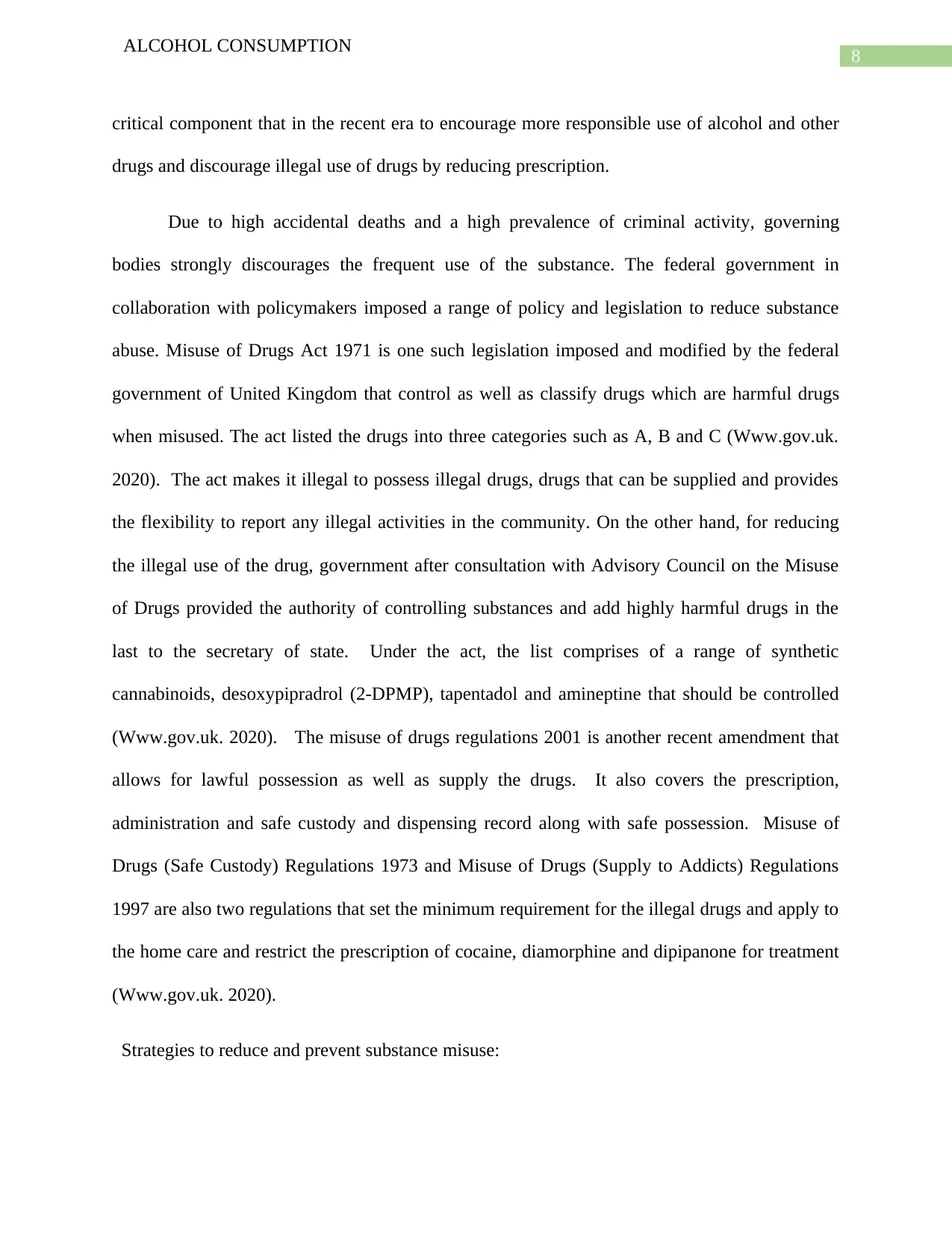
8
ALCOHOL CONSUMPTION
critical component that in the recent era to encourage more responsible use of alcohol and other
drugs and discourage illegal use of drugs by reducing prescription.
Due to high accidental deaths and a high prevalence of criminal activity, governing
bodies strongly discourages the frequent use of the substance. The federal government in
collaboration with policymakers imposed a range of policy and legislation to reduce substance
abuse. Misuse of Drugs Act 1971 is one such legislation imposed and modified by the federal
government of United Kingdom that control as well as classify drugs which are harmful drugs
when misused. The act listed the drugs into three categories such as A, B and C (Www.gov.uk.
2020). The act makes it illegal to possess illegal drugs, drugs that can be supplied and provides
the flexibility to report any illegal activities in the community. On the other hand, for reducing
the illegal use of the drug, government after consultation with Advisory Council on the Misuse
of Drugs provided the authority of controlling substances and add highly harmful drugs in the
last to the secretary of state. Under the act, the list comprises of a range of synthetic
cannabinoids, desoxypipradrol (2-DPMP), tapentadol and amineptine that should be controlled
(Www.gov.uk. 2020). The misuse of drugs regulations 2001 is another recent amendment that
allows for lawful possession as well as supply the drugs. It also covers the prescription,
administration and safe custody and dispensing record along with safe possession. Misuse of
Drugs (Safe Custody) Regulations 1973 and Misuse of Drugs (Supply to Addicts) Regulations
1997 are also two regulations that set the minimum requirement for the illegal drugs and apply to
the home care and restrict the prescription of cocaine, diamorphine and dipipanone for treatment
(Www.gov.uk. 2020).
Strategies to reduce and prevent substance misuse:
ALCOHOL CONSUMPTION
critical component that in the recent era to encourage more responsible use of alcohol and other
drugs and discourage illegal use of drugs by reducing prescription.
Due to high accidental deaths and a high prevalence of criminal activity, governing
bodies strongly discourages the frequent use of the substance. The federal government in
collaboration with policymakers imposed a range of policy and legislation to reduce substance
abuse. Misuse of Drugs Act 1971 is one such legislation imposed and modified by the federal
government of United Kingdom that control as well as classify drugs which are harmful drugs
when misused. The act listed the drugs into three categories such as A, B and C (Www.gov.uk.
2020). The act makes it illegal to possess illegal drugs, drugs that can be supplied and provides
the flexibility to report any illegal activities in the community. On the other hand, for reducing
the illegal use of the drug, government after consultation with Advisory Council on the Misuse
of Drugs provided the authority of controlling substances and add highly harmful drugs in the
last to the secretary of state. Under the act, the list comprises of a range of synthetic
cannabinoids, desoxypipradrol (2-DPMP), tapentadol and amineptine that should be controlled
(Www.gov.uk. 2020). The misuse of drugs regulations 2001 is another recent amendment that
allows for lawful possession as well as supply the drugs. It also covers the prescription,
administration and safe custody and dispensing record along with safe possession. Misuse of
Drugs (Safe Custody) Regulations 1973 and Misuse of Drugs (Supply to Addicts) Regulations
1997 are also two regulations that set the minimum requirement for the illegal drugs and apply to
the home care and restrict the prescription of cocaine, diamorphine and dipipanone for treatment
(Www.gov.uk. 2020).
Strategies to reduce and prevent substance misuse:
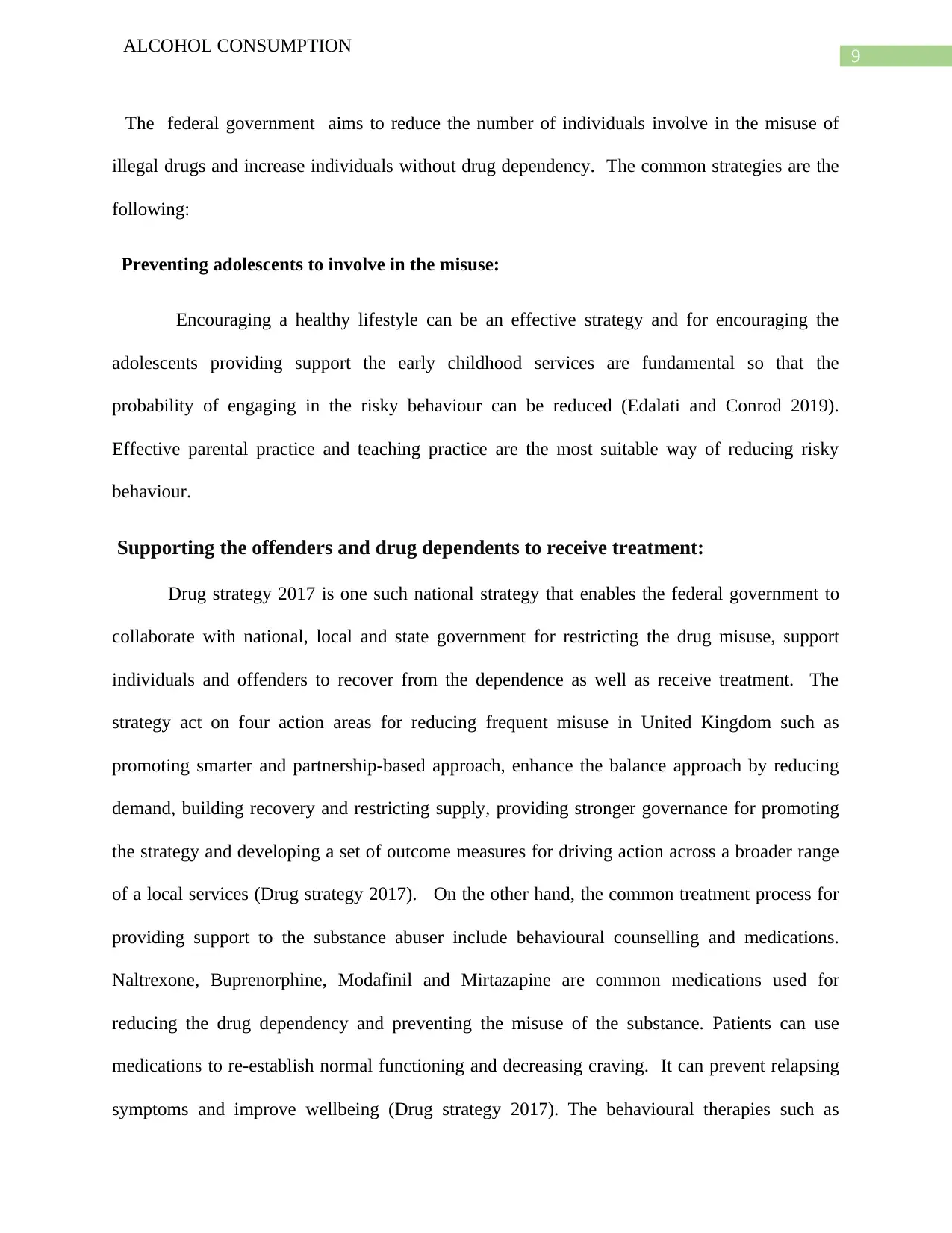
9
ALCOHOL CONSUMPTION
The federal government aims to reduce the number of individuals involve in the misuse of
illegal drugs and increase individuals without drug dependency. The common strategies are the
following:
Preventing adolescents to involve in the misuse:
Encouraging a healthy lifestyle can be an effective strategy and for encouraging the
adolescents providing support the early childhood services are fundamental so that the
probability of engaging in the risky behaviour can be reduced (Edalati and Conrod 2019).
Effective parental practice and teaching practice are the most suitable way of reducing risky
behaviour.
Supporting the offenders and drug dependents to receive treatment:
Drug strategy 2017 is one such national strategy that enables the federal government to
collaborate with national, local and state government for restricting the drug misuse, support
individuals and offenders to recover from the dependence as well as receive treatment. The
strategy act on four action areas for reducing frequent misuse in United Kingdom such as
promoting smarter and partnership-based approach, enhance the balance approach by reducing
demand, building recovery and restricting supply, providing stronger governance for promoting
the strategy and developing a set of outcome measures for driving action across a broader range
of a local services (Drug strategy 2017). On the other hand, the common treatment process for
providing support to the substance abuser include behavioural counselling and medications.
Naltrexone, Buprenorphine, Modafinil and Mirtazapine are common medications used for
reducing the drug dependency and preventing the misuse of the substance. Patients can use
medications to re-establish normal functioning and decreasing craving. It can prevent relapsing
symptoms and improve wellbeing (Drug strategy 2017). The behavioural therapies such as
ALCOHOL CONSUMPTION
The federal government aims to reduce the number of individuals involve in the misuse of
illegal drugs and increase individuals without drug dependency. The common strategies are the
following:
Preventing adolescents to involve in the misuse:
Encouraging a healthy lifestyle can be an effective strategy and for encouraging the
adolescents providing support the early childhood services are fundamental so that the
probability of engaging in the risky behaviour can be reduced (Edalati and Conrod 2019).
Effective parental practice and teaching practice are the most suitable way of reducing risky
behaviour.
Supporting the offenders and drug dependents to receive treatment:
Drug strategy 2017 is one such national strategy that enables the federal government to
collaborate with national, local and state government for restricting the drug misuse, support
individuals and offenders to recover from the dependence as well as receive treatment. The
strategy act on four action areas for reducing frequent misuse in United Kingdom such as
promoting smarter and partnership-based approach, enhance the balance approach by reducing
demand, building recovery and restricting supply, providing stronger governance for promoting
the strategy and developing a set of outcome measures for driving action across a broader range
of a local services (Drug strategy 2017). On the other hand, the common treatment process for
providing support to the substance abuser include behavioural counselling and medications.
Naltrexone, Buprenorphine, Modafinil and Mirtazapine are common medications used for
reducing the drug dependency and preventing the misuse of the substance. Patients can use
medications to re-establish normal functioning and decreasing craving. It can prevent relapsing
symptoms and improve wellbeing (Drug strategy 2017). The behavioural therapies such as
⊘ This is a preview!⊘
Do you want full access?
Subscribe today to unlock all pages.

Trusted by 1+ million students worldwide
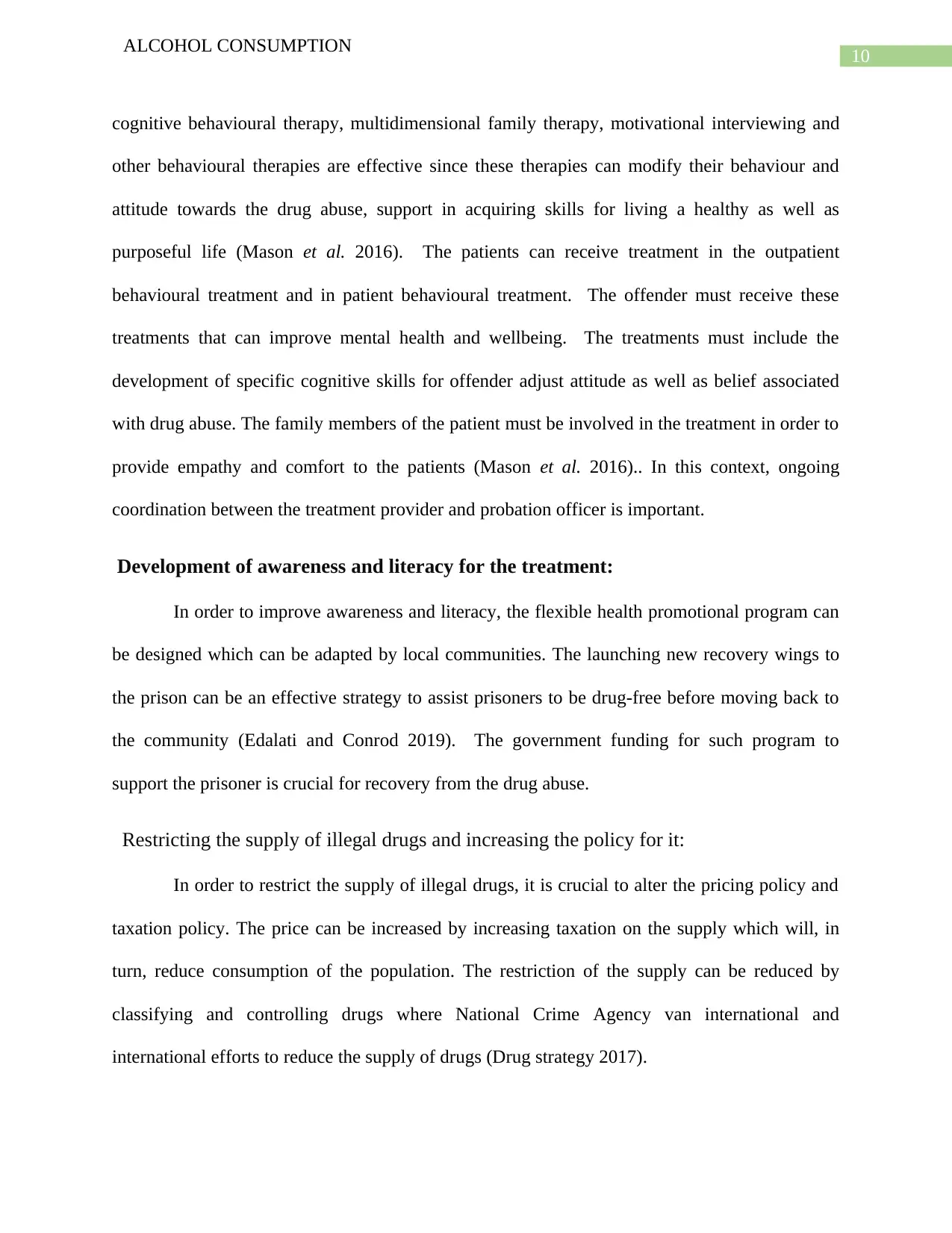
10
ALCOHOL CONSUMPTION
cognitive behavioural therapy, multidimensional family therapy, motivational interviewing and
other behavioural therapies are effective since these therapies can modify their behaviour and
attitude towards the drug abuse, support in acquiring skills for living a healthy as well as
purposeful life (Mason et al. 2016). The patients can receive treatment in the outpatient
behavioural treatment and in patient behavioural treatment. The offender must receive these
treatments that can improve mental health and wellbeing. The treatments must include the
development of specific cognitive skills for offender adjust attitude as well as belief associated
with drug abuse. The family members of the patient must be involved in the treatment in order to
provide empathy and comfort to the patients (Mason et al. 2016).. In this context, ongoing
coordination between the treatment provider and probation officer is important.
Development of awareness and literacy for the treatment:
In order to improve awareness and literacy, the flexible health promotional program can
be designed which can be adapted by local communities. The launching new recovery wings to
the prison can be an effective strategy to assist prisoners to be drug-free before moving back to
the community (Edalati and Conrod 2019). The government funding for such program to
support the prisoner is crucial for recovery from the drug abuse.
Restricting the supply of illegal drugs and increasing the policy for it:
In order to restrict the supply of illegal drugs, it is crucial to alter the pricing policy and
taxation policy. The price can be increased by increasing taxation on the supply which will, in
turn, reduce consumption of the population. The restriction of the supply can be reduced by
classifying and controlling drugs where National Crime Agency van international and
international efforts to reduce the supply of drugs (Drug strategy 2017).
ALCOHOL CONSUMPTION
cognitive behavioural therapy, multidimensional family therapy, motivational interviewing and
other behavioural therapies are effective since these therapies can modify their behaviour and
attitude towards the drug abuse, support in acquiring skills for living a healthy as well as
purposeful life (Mason et al. 2016). The patients can receive treatment in the outpatient
behavioural treatment and in patient behavioural treatment. The offender must receive these
treatments that can improve mental health and wellbeing. The treatments must include the
development of specific cognitive skills for offender adjust attitude as well as belief associated
with drug abuse. The family members of the patient must be involved in the treatment in order to
provide empathy and comfort to the patients (Mason et al. 2016).. In this context, ongoing
coordination between the treatment provider and probation officer is important.
Development of awareness and literacy for the treatment:
In order to improve awareness and literacy, the flexible health promotional program can
be designed which can be adapted by local communities. The launching new recovery wings to
the prison can be an effective strategy to assist prisoners to be drug-free before moving back to
the community (Edalati and Conrod 2019). The government funding for such program to
support the prisoner is crucial for recovery from the drug abuse.
Restricting the supply of illegal drugs and increasing the policy for it:
In order to restrict the supply of illegal drugs, it is crucial to alter the pricing policy and
taxation policy. The price can be increased by increasing taxation on the supply which will, in
turn, reduce consumption of the population. The restriction of the supply can be reduced by
classifying and controlling drugs where National Crime Agency van international and
international efforts to reduce the supply of drugs (Drug strategy 2017).
Paraphrase This Document
Need a fresh take? Get an instant paraphrase of this document with our AI Paraphraser
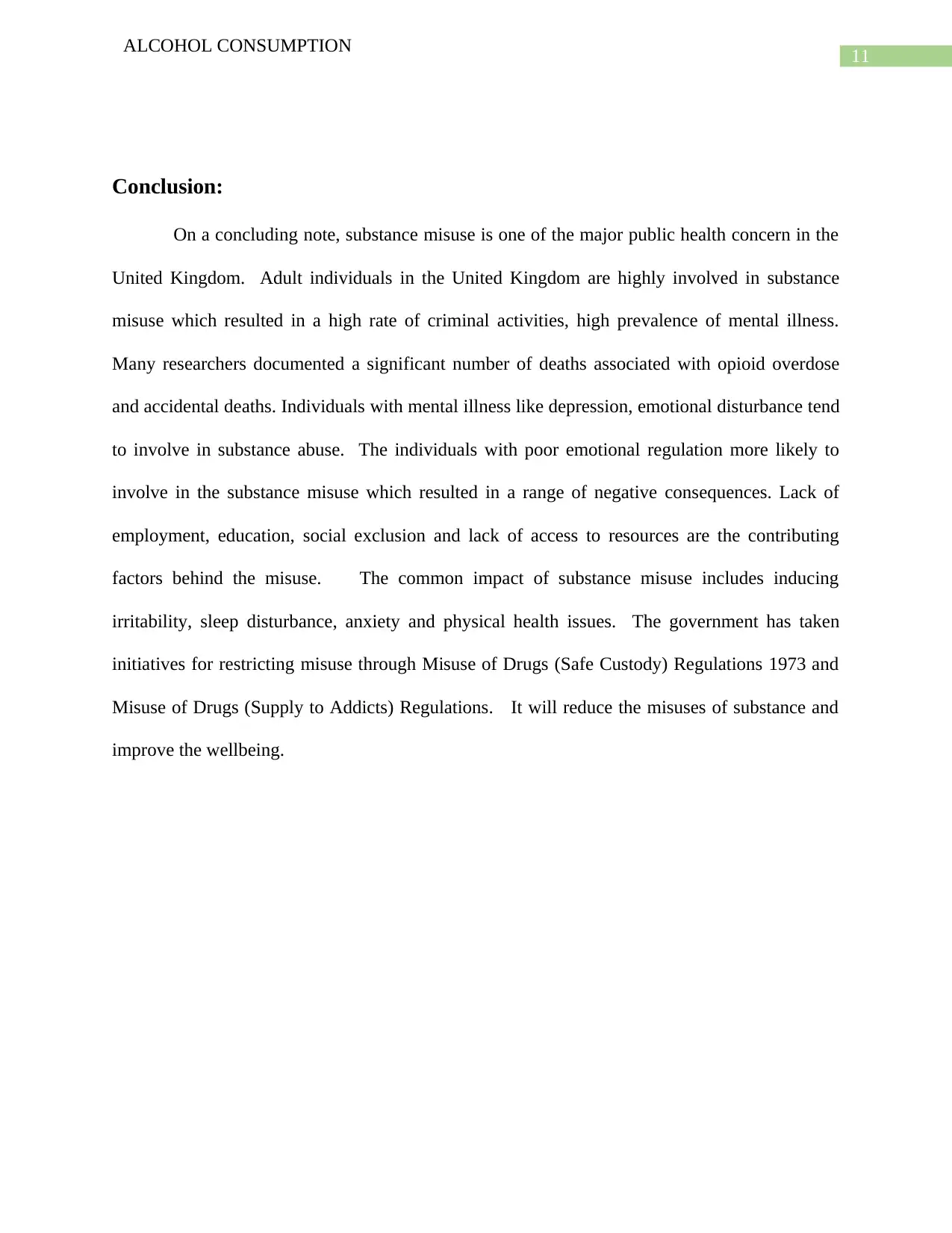
11
ALCOHOL CONSUMPTION
Conclusion:
On a concluding note, substance misuse is one of the major public health concern in the
United Kingdom. Adult individuals in the United Kingdom are highly involved in substance
misuse which resulted in a high rate of criminal activities, high prevalence of mental illness.
Many researchers documented a significant number of deaths associated with opioid overdose
and accidental deaths. Individuals with mental illness like depression, emotional disturbance tend
to involve in substance abuse. The individuals with poor emotional regulation more likely to
involve in the substance misuse which resulted in a range of negative consequences. Lack of
employment, education, social exclusion and lack of access to resources are the contributing
factors behind the misuse. The common impact of substance misuse includes inducing
irritability, sleep disturbance, anxiety and physical health issues. The government has taken
initiatives for restricting misuse through Misuse of Drugs (Safe Custody) Regulations 1973 and
Misuse of Drugs (Supply to Addicts) Regulations. It will reduce the misuses of substance and
improve the wellbeing.
ALCOHOL CONSUMPTION
Conclusion:
On a concluding note, substance misuse is one of the major public health concern in the
United Kingdom. Adult individuals in the United Kingdom are highly involved in substance
misuse which resulted in a high rate of criminal activities, high prevalence of mental illness.
Many researchers documented a significant number of deaths associated with opioid overdose
and accidental deaths. Individuals with mental illness like depression, emotional disturbance tend
to involve in substance abuse. The individuals with poor emotional regulation more likely to
involve in the substance misuse which resulted in a range of negative consequences. Lack of
employment, education, social exclusion and lack of access to resources are the contributing
factors behind the misuse. The common impact of substance misuse includes inducing
irritability, sleep disturbance, anxiety and physical health issues. The government has taken
initiatives for restricting misuse through Misuse of Drugs (Safe Custody) Regulations 1973 and
Misuse of Drugs (Supply to Addicts) Regulations. It will reduce the misuses of substance and
improve the wellbeing.
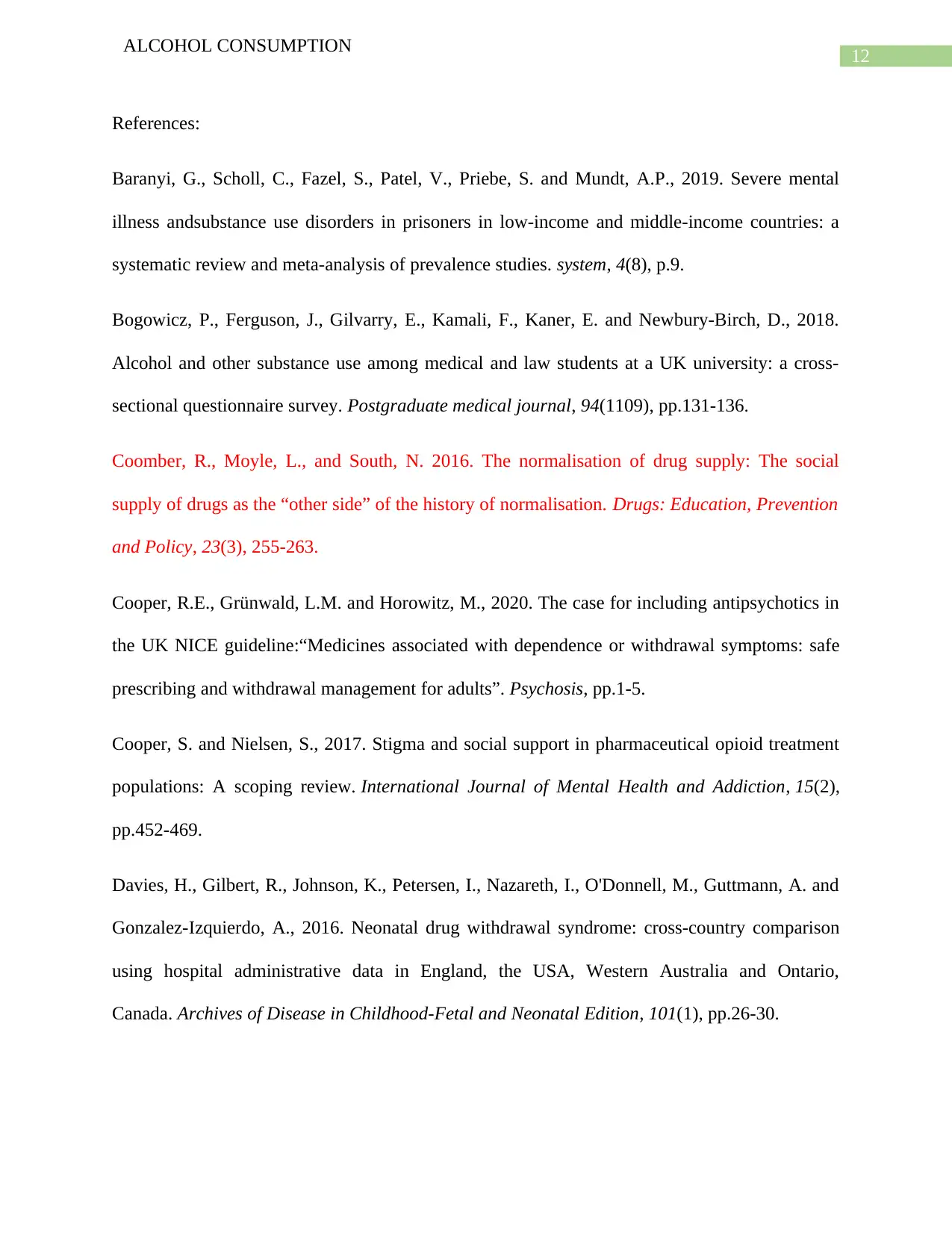
12
ALCOHOL CONSUMPTION
References:
Baranyi, G., Scholl, C., Fazel, S., Patel, V., Priebe, S. and Mundt, A.P., 2019. Severe mental
illness andsubstance use disorders in prisoners in low-income and middle-income countries: a
systematic review and meta-analysis of prevalence studies. system, 4(8), p.9.
Bogowicz, P., Ferguson, J., Gilvarry, E., Kamali, F., Kaner, E. and Newbury-Birch, D., 2018.
Alcohol and other substance use among medical and law students at a UK university: a cross-
sectional questionnaire survey. Postgraduate medical journal, 94(1109), pp.131-136.
Coomber, R., Moyle, L., and South, N. 2016. The normalisation of drug supply: The social
supply of drugs as the “other side” of the history of normalisation. Drugs: Education, Prevention
and Policy, 23(3), 255-263.
Cooper, R.E., Grünwald, L.M. and Horowitz, M., 2020. The case for including antipsychotics in
the UK NICE guideline:“Medicines associated with dependence or withdrawal symptoms: safe
prescribing and withdrawal management for adults”. Psychosis, pp.1-5.
Cooper, S. and Nielsen, S., 2017. Stigma and social support in pharmaceutical opioid treatment
populations: A scoping review. International Journal of Mental Health and Addiction, 15(2),
pp.452-469.
Davies, H., Gilbert, R., Johnson, K., Petersen, I., Nazareth, I., O'Donnell, M., Guttmann, A. and
Gonzalez-Izquierdo, A., 2016. Neonatal drug withdrawal syndrome: cross-country comparison
using hospital administrative data in England, the USA, Western Australia and Ontario,
Canada. Archives of Disease in Childhood-Fetal and Neonatal Edition, 101(1), pp.26-30.
ALCOHOL CONSUMPTION
References:
Baranyi, G., Scholl, C., Fazel, S., Patel, V., Priebe, S. and Mundt, A.P., 2019. Severe mental
illness andsubstance use disorders in prisoners in low-income and middle-income countries: a
systematic review and meta-analysis of prevalence studies. system, 4(8), p.9.
Bogowicz, P., Ferguson, J., Gilvarry, E., Kamali, F., Kaner, E. and Newbury-Birch, D., 2018.
Alcohol and other substance use among medical and law students at a UK university: a cross-
sectional questionnaire survey. Postgraduate medical journal, 94(1109), pp.131-136.
Coomber, R., Moyle, L., and South, N. 2016. The normalisation of drug supply: The social
supply of drugs as the “other side” of the history of normalisation. Drugs: Education, Prevention
and Policy, 23(3), 255-263.
Cooper, R.E., Grünwald, L.M. and Horowitz, M., 2020. The case for including antipsychotics in
the UK NICE guideline:“Medicines associated with dependence or withdrawal symptoms: safe
prescribing and withdrawal management for adults”. Psychosis, pp.1-5.
Cooper, S. and Nielsen, S., 2017. Stigma and social support in pharmaceutical opioid treatment
populations: A scoping review. International Journal of Mental Health and Addiction, 15(2),
pp.452-469.
Davies, H., Gilbert, R., Johnson, K., Petersen, I., Nazareth, I., O'Donnell, M., Guttmann, A. and
Gonzalez-Izquierdo, A., 2016. Neonatal drug withdrawal syndrome: cross-country comparison
using hospital administrative data in England, the USA, Western Australia and Ontario,
Canada. Archives of Disease in Childhood-Fetal and Neonatal Edition, 101(1), pp.26-30.
⊘ This is a preview!⊘
Do you want full access?
Subscribe today to unlock all pages.

Trusted by 1+ million students worldwide
1 out of 15
Related Documents
Your All-in-One AI-Powered Toolkit for Academic Success.
+13062052269
info@desklib.com
Available 24*7 on WhatsApp / Email
![[object Object]](/_next/static/media/star-bottom.7253800d.svg)
Unlock your academic potential
Copyright © 2020–2025 A2Z Services. All Rights Reserved. Developed and managed by ZUCOL.

